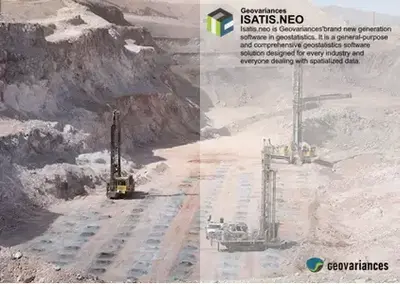Geovariances ISATIS.NEO Mining Edition 2024.04
Isatis.neo is the leading and most comprehensive software solution for geostatistics. Featuring an intuitive user interface, it results from Geovariances’ dual commitment to developing breakthrough technology and making premium geostatistics accessible to more users.

Designed for every business dealing with spatialized data, Isatis.neo exceeds industry standards in geostatistics. The software enables thorough data analysis and visualization, produces high-quality maps and models, and allows you to carry out extensive uncertainty and risk analyses that optimize your decision-making process.
Available in a Standard Edition, Isatis.neo is also offered in two special versions, Petroleum Edition and Mining Edition, to better meet the specific requirements of these two industries. In addition to business-oriented tools, the Petroleum Edition offers a preconfigured workflow for Time-to-Depth Conversion with comprehensive uncertainty analysis.
ISATIS.NEO KEY FEATURES
Integrated and powerful application for Exploratory Data Analysis in univariate and multivariate contexts.
Automatic sample clustering for the definition of homogeneous geological facies classes. Border analysis.
Built-in tools for drill hole compositing, data declustering, PCA, MAF, PPMT, KNA, cross-validation, local varying anisotropies, variable capping, unfolding.
Classical interpolation methods (nearest neighbor, inverse distance, moving average, moving median).
Industry-standard estimation methods (point, block, on subblocks, simple, ordinary, universal, multivariate, spline, linear kriging, kriging with external drift).
Advanced estimation methods (rescaled cokriging, kriging with uncertain data, faults, filtering model components, Mixed Support Kriging, using local parameters, using Sampling Density Variance, conditional expectation).
Conditional and non-conditional simulations (SGS, TBS, Direct Block Simulations, SPDE, Cox). Simulation reduction. Genuine simulation post-processing for robust uncertainty and risk analysis.
Sequential Indicator Simulations, Plurigaussian Simulations, Multiple-point Statistics for modeling subsurface, reservoir, or orebody geology.
Estimation validation / Simulation validation.
Uniform Conditioning, LMUC, MIK.
Python functionalities and coding.
Great interoperability.
File Size: 782 MB
Download
http://s9.alxa.net/one/2024/11/Geova...on.2024.04.rar
Isatis.neo is the leading and most comprehensive software solution for geostatistics. Featuring an intuitive user interface, it results from Geovariances’ dual commitment to developing breakthrough technology and making premium geostatistics accessible to more users.

Designed for every business dealing with spatialized data, Isatis.neo exceeds industry standards in geostatistics. The software enables thorough data analysis and visualization, produces high-quality maps and models, and allows you to carry out extensive uncertainty and risk analyses that optimize your decision-making process.
Available in a Standard Edition, Isatis.neo is also offered in two special versions, Petroleum Edition and Mining Edition, to better meet the specific requirements of these two industries. In addition to business-oriented tools, the Petroleum Edition offers a preconfigured workflow for Time-to-Depth Conversion with comprehensive uncertainty analysis.
ISATIS.NEO KEY FEATURES
Integrated and powerful application for Exploratory Data Analysis in univariate and multivariate contexts.
Automatic sample clustering for the definition of homogeneous geological facies classes. Border analysis.
Built-in tools for drill hole compositing, data declustering, PCA, MAF, PPMT, KNA, cross-validation, local varying anisotropies, variable capping, unfolding.
Classical interpolation methods (nearest neighbor, inverse distance, moving average, moving median).
Industry-standard estimation methods (point, block, on subblocks, simple, ordinary, universal, multivariate, spline, linear kriging, kriging with external drift).
Advanced estimation methods (rescaled cokriging, kriging with uncertain data, faults, filtering model components, Mixed Support Kriging, using local parameters, using Sampling Density Variance, conditional expectation).
Conditional and non-conditional simulations (SGS, TBS, Direct Block Simulations, SPDE, Cox). Simulation reduction. Genuine simulation post-processing for robust uncertainty and risk analysis.
Sequential Indicator Simulations, Plurigaussian Simulations, Multiple-point Statistics for modeling subsurface, reservoir, or orebody geology.
Estimation validation / Simulation validation.
Uniform Conditioning, LMUC, MIK.
Python functionalities and coding.
Great interoperability.
File Size: 782 MB
Download
http://s9.alxa.net/one/2024/11/Geova...on.2024.04.rar